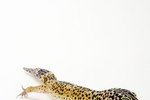
As a cold-blooded creature who requires plenty of moisture, a frog must be find ways to deal with extreme cold, heat and drought. To survive these conditions he uses estivation and hibernation, which are similar but different ways of slowing his metabolism and other functions so he can hide out in a safe place until conditions are sustainable again.
Estivation
Estivation, also spelled aestivation, is similar to hibernation. When a frog estivates, his heart rate and digestive system slow dramatically, allowing him to spend several months, and in some cases more than a year, without eating or moving. His fat stores provide energy. Unlike a human, the frog does not lose muscle tone or flexibility as a result of prolonged immobility. Frogs estivate to survive hot summer temperatures or periods of drought. Hibernation, on the other hand, is a frog's means of surviving freezing winter temperatures.
Location
Most frogs dig a small but deep burrow in mud or sand for estivation. The burrow protects the frog from drying out in the hot sun until the next rain. As additional protection against dehydration, many types of frogs create cocoons that lock in moisture. These cocoons sometimes appear as though the frogs' skin has become dried and hard; eventually it breaks away, revealing normal skin underneath. Frogs that do not dig or burrow will find cracks or holes in logs and rocks for estivation, while others will hide under leaf litter or in burrows created by other small animals.
Moisture
Unlike hibernation, which is triggered by the season or number of daylight hours, estivation is triggered by the amount of available moisture, regardless of the time of year. When there isn't enough moisture for a frog to survive, the frog buries himself in the mud, sand or other shelter where his bodily functions slow down enough that he can survive until the next rain. As soon as moisture arrives, the frog emerges and his heart rate, breathing and digestion return to normal. He will return to estivation if conditions become too dry again.
Hibernation
Frogs who live in cold weather areas hibernate as a means of surviving freezing temperatures. While some frogs dig burrows in the mud or sand to hibernate, others find hiding places in rocks or trees and rely on a high blood glucose level, which acts similar to automotive antifreeze, to keep from freezing to death. A few frogs, like the American bullfrog, hibernate at the bottom of ponds and lakes, but do not bury themselves in the mud since they absorb oxygen from the water through their skin to survive.
References
Photo Credits
-
Jupiterimages/Photos.com/Getty Images



